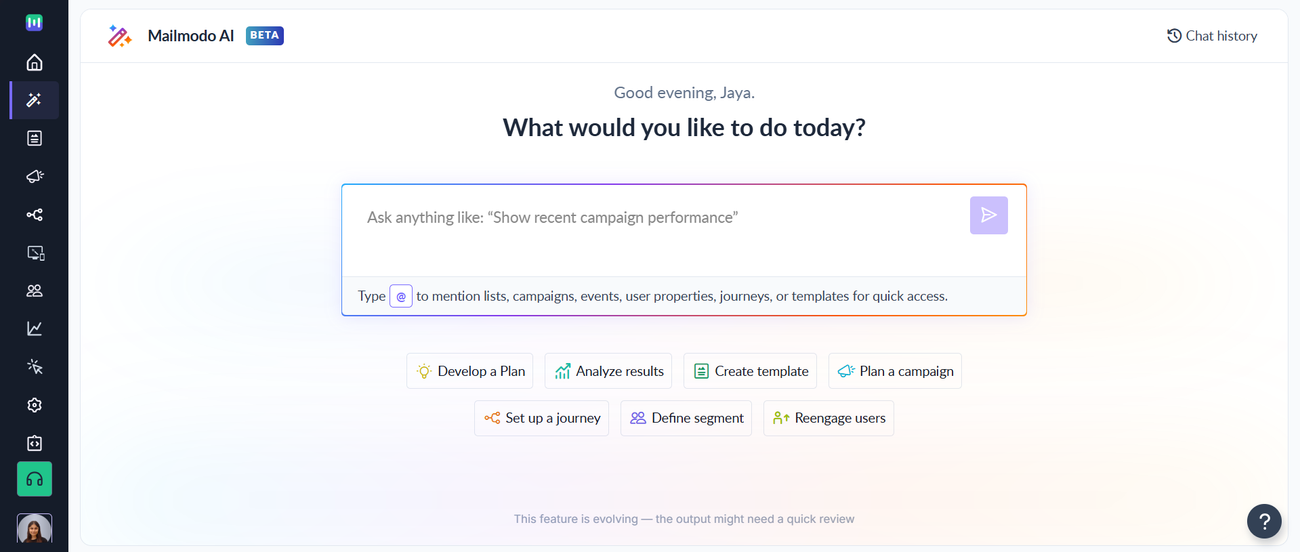What are the filters available for segmentation using campaign activity?
Last updated November 3, 2025
Segmenting your contacts using campaign activity is important because it allows you to target contacts based on their engagement with your email campaigns. By tracking campaign activity, you can gain valuable insights into how your contacts are interacting with your content, which messages are resonating with them, and which calls-to-action are driving the most conversions.
Using campaign activity segmentation in Mailmodo, you can create highly targeted segments based on various criteria. Some of the filters available for segmentation using campaign activity in Mailmodo include:
- Email sent: You can filter your contacts based on whether or not they have been sent a specific email campaign or any campaign.
- Email open: You can filter your contacts based on whether or not they have opened a specific email campaign or any campaign.
- Email click: You can filter your contacts based on whether or not they have clicked on a link within a specific email campaign or any campaign.
- Email submission: You can filter your contacts based on whether or not they have submitted a specific email campaign or any campaign.
- Campaign name: You can filter your contacts based on specific campaigns that they have engaged with in Mailmodo.
- Campaign date: You can filter your contacts based on when they engaged with any email campaigns, allowing you to target contacts who have recently interacted with your brand.
- Apple privacy open: You can filter Apple Mail Privacy Protection opens from genuine recipient engagement by utilizing this filter in the User has opened activity condition in Segmentation. Here is the definitive guide to understanding Apple privacy opens.
Please note that only the first instances of email opens, clicks, and form submissions are taken into account for filtering contacts in segmentation| Filter | Options | Definition |
| Engagement | Was sent | Returns all the contacts where the contacts were sent email campaign/s |
| Was not sent | Returns all the contacts where the contacts were not sent email campaign/s | |
| User has opened | Returns all the contacts where the contacts have opened email campaign/s. | |
| User has not opened | Returns all the contacts where the contacts have not opened email campaign/s | |
| User has clicked | Returns all the contacts where the contacts have clicked email campaign/s | |
| User has not clicked | Returns all the contacts where the contacts have not clicked email campaign/s | |
| User has submitted | Returns all the contacts where the contacts have submitted email campaign/s | |
| User has not submitted | Returns all the contacts where the contacts have not clicked email campaign/s | |
| Campaign name | Specific campaign/s | Returns all contacts pertaining to specific campaign/s |
| Any campaigns | Returns all contacts pertaining to any campaigns | |
| Campaign date > Any campaigns | Until now | Returns all the contacts engaged/not engaged until now |
| In the last | Returns all the contacts engaged/not engaged in the last <n> days. "n" value as provided by the user | |
| Between | Returns all the contacts engaged/not engaged in between two relative dates in the past. For example between 3 and 7 days ago returns contacts between 7day ago and 3 days ago | |
| Between dates | Returns all the contacts engaged/not engaged in between the two specific dates. Includes the dates where the date is equal to the queried dates | |
| On | Returns all the contacts engaged/not engaged on the specified date | |
| After | Returns all the contacts engaged/not engaged after the specified date | |
| Before | Returns all the contacts engaged/not engaged before the specified date | |
| User has opened > Apple privacy open | Set to true | Returns all the contacts where the mail was opened at least once on a device with MPP turned on |
| Set to false | Returns all the contacts where the mail was opened an any other devices |
Using these filters, you can create highly targeted segments of your audience and deliver personalized messaging that speaks to their specific interests and behaviors. This can help improve engagement, increase conversions, and ultimately drive revenue for your business.
With Mailmodo AI✨, you can easily create segments based on your requirements, complex audience segments are now just a prompt away! Try it out today.


